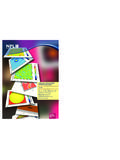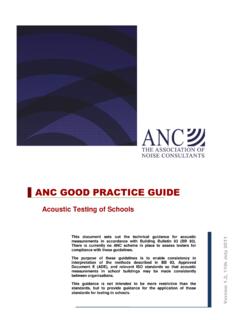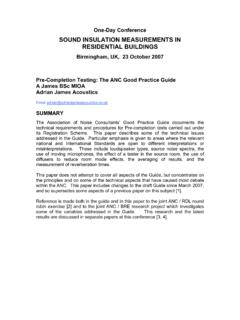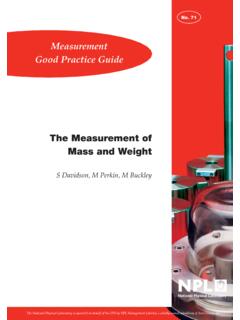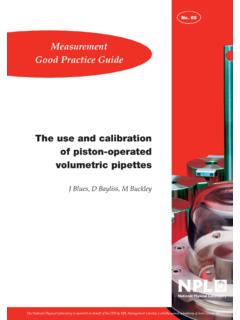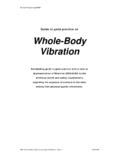Transcription of Measurement Good Practice Guide No. 66 …
1 Measurement good Practice Guide No. 66 Solderability Testing of Surface Mount Components and PCB Pads Ling Zou, Deborah Lea and Chris Hunt NPL Materials Centre National Physical Laboratory Abstract: This document guides you to choose the correct test parameter settings for solderability testing of different type and size surface mount components and PCB pads. Pass/fail criteria are suggested and examples of good and bad solderability curves for each type component and PCB pad are given in the document to help you to judge the solderability of test component. Crown Copyright 2004 Reproduced by permission of the Controller of HMSO ISSN 1368-6550 February 2004 National Physical Laboratory Teddington, Middlesex, United Kingdom, TW11 0LW Website: Guidelines for Solderability Testing of Surface Mount Components and PCB Pads Contents 1 1 2 Test Description.
2 1 3 Terminology .. 2 4 Test Method .. 2 5 Methodology .. 2 PCB pad .. 2 Chip Capacitor .. 4 7 PLCC .. 9 QFP .. 11 Chip Resistor .. 13 Wire .. 15 SOIC .. 18 20 Measurement good Practice Guide No. 66 1 1 Introduction The wetting balance test is the most useful tool for investigating the soldering properties of surface mount components, terminations and leads, and PCB pads. A wetting balance is used to measure the force involved when a molten solder wets the sample surface. This gives a measure of quality of the surface in terms of the ability of solder to wet it. A typical wetting curve is shown in the figure below.
3 Very common solderability indexes are the wetting time T and wetting force F. The wetting time is the time passed until the force has reached two thirds of its maximum, measured from the buoyancy line, a value equal to or less than two seconds is considered an acceptable value. Wetting force is the force measured at two seconds. There is no specification placed upon what the minimum force should be. Measuring the solderability for a range of components and PCB pad sizes has allowed us to assess the pass/fail criteria for acceptable solderability (ref. CMMT(A)284 and MATC(A)003). Test parameters are listed below according to component type along with suggested acceptable values for both T (secs.)
4 And F (mN/mm, mN/mm2, mN). 2/3 of Fmaxwetting curve-ve+vet0f0T = time to 2/3 maximum forceF1 = wetting force @ 2secMaximum ForceForce (mN)Time (seconds) 2 Test Description The tests have been carried out on a Multicore Must II wetting balance. The instrument is used in either the solder globule or solder bath mode, depending on the component type to be tested. A 60/40 SnPb solder alloy or lead-free alloy such as SnAgCu can be used for both types of mode. The solder temperature is dependent on the choice of solder alloy. Immersion speed and immersion depth are dependent on component type. The flux used and recommended here is pure rosin with halide, in accordance with IEC 68-2-20, although the IEC standard does allow rosin based fluxes with and 0% halide as well.
5 However, the solder globule must be fluxed with rosin with halide. Force data is typically acquired over a 5 or 10 second period. More specific details are listed under the individual component headings below. Generally 10 terminations need to be tested for per batch of components or PCB pads. Measurement good Practice Guide No. 66 2 3 Terminology (According to ANSI/IPC-T-50C) Component Pad: It is the metallic surface to which the solder wets. Flux: A chemically/physically active formulation that is capable of enabling and promoting the wetting of metals with solder. Solderability: The ability of a metal to be wetted by molten solder. Wetting: The formation of a uniform, smooth, unbroken, and adherent film of the solder to a base metal.
6 4 Test Method The component is mounted onto the appropriate clip and liquid flux applied to the component pad. The specimen is hung from a sensitive balance. Rosin based with halide flux is added to the solder globule. The solder globule is brought into contact with the component termination, and immersed to the required depth for the directed duration. 5 Methodology PCB pad Apparatus: Wetting Balance, in solder globule mode, 25 mg or 200 mg pellet, depending on PCB pad size. Schematic view of the component: Test Conditions: Component preconditioning: None, test on as received components. Special Preparation: Pads may need to be cut from a board, using a guillotine.
7 Any rough edges resulting from the cut should be lightly abraded using emery paper and gently cleaned with iso-propanol. Test pad number: Typically 10 pads per board. Measurement good Practice Guide No. 66 3 Solder Alloy: Sn/Pb 60/40 (according to ISO 9453). SnAgCu (according to EN 29453). Flux for the Component Termination: Rosin based, % activated flux (according to IEC 68-2-20). Solder Temperature: 235 OC 3 OC for SnPb solder alloy, for lead-free alloys with a melting point equal to or greater than 215 OC, a superheat temperature of +40 OC is used. Immersion Speed: mm/s Duration of Immersion: 10 seconds Immersion Depth Termination: mm Preheat: No preheat.
8 Component Position above the Solder Globule: 4 mm 1 mmGlobule AxisSolder GlobuleTest pad45o Pass/Fail Criteria: Wetting Time: Less than 2 seconds. Wetting Force at 2 seconds: Greater or equal to mN/mm2 (area of pad) Examples of Solderability: good Solderability: Example of good solderability curve Poor Solderability: Example of poor solderability curve Measurement good Practice Guide No. 66 4 (secs)Force (mN) good solderability curve of PCB pad (secs)Force (mN)Poor solderability curve of PCB pad Chip Capacitor Methodology: 0402, 0603, 0805, 1206, 1812 Apparatus: Wetting Balance, in solder globule mode, 25 mg pellet for 0402s and 0603s, 200 mg pellet for 0805s, 1206s and 1812s.
9 Schematic view of component: Measurement good Practice Guide No. 66 5 Test Conditions: Component preconditioning: None, test on as received components. Special Preparation: None. Test termination number: One termination per component. Solder Alloy: Sn/Pb 60/40 (according to ISO 9453). SnAgCu (according to EN 29453). Flux for the Component Termination: Rosin based, % activated flux (according to IEC 68-2-20). Solder Temperature: 235 OC 3 OC for SnPb solder alloys, for lead-free alloys with a melting point equal to or greater than 215 OC, a superheat temperature of +40 O C is used.
10 Immersion Speed: mm/s Duration of Immersion: 5 seconds Immersion Depth Termination: mm Preheat: No preheat. Component Position above Solder Globule: 0402s and 0603s 4 mm 1 mm 90oGlobule AxisTest termination Measurement good Practice Guide No. 66 6 0805s, 1206s and 1812s Pass/Fail Criteria Wetting Time: Less than 2 seconds. Examples of Solderability: good Solderability: Example of good solderability Poor Solderability: Example of poor solderability (secs)Force (mN) good solderability curve of capacitor 4 mm 1 mm 90oGlobule AxisTest termination Measurement good Practice Guide No.

